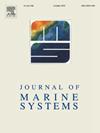圣豪尔赫湾(巴塔哥尼亚大陆架)仲夏水柱物理特性和环流观测数据
IF 2.5
3区 地球科学
Q2 GEOSCIENCES, MULTIDISCIPLINARY
引用次数: 0
摘要
在本研究中,我们详细介绍了圣豪尔赫湾(阿根廷巴塔哥尼亚大陆架)内的仲夏密度场和流动模式。我们利用配备了电导率-温度-深度(CTD)传感器和船体安装的声学多普勒海流剖面仪(ADCP)的拖曳式起伏潜水器获取的独特数据,研究了密度结构和相关海流的空间分布和时间演变。我们的观测结果表明,仲夏时节,海湾中部海盆中存在一个独特的海底穹顶状结构,由浓密、寒冷的盐水组成。对水流动力学的分析表明,这种稠密的水域是由一种近地养水流机制维持的。此外,我们的研究还强调了老化速度的重要作用,它主要受 M2+M4 内潮对 pycnocline 厚度的调节作用的影响。这些发现有助于更深入地了解圣乔治湾夏季中期动态的海洋学过程,揭示密度结构与相关海流之间的相互作用。这些见解对于增进我们对沿岸海洋环流及其对各种生态和环境现象的影响的了解至关重要。本文章由计算机程序翻译,如有差异,请以英文原文为准。
Mid-Summer observations of water column physical properties and circulation in the San Jorge Gulf (Patagonian Shelf)
In this study, we present detailed insights into the mid-summer density field and flow patterns within the San Jorge Gulf (Patagonian Shelf of Argentina). Utilizing unique data acquired from a towed undulating vehicle equipped with a Conductivity-Temperature-Depth (CTD) sensor and a hull-mounted acoustic Doppler current profiler (ADCP), we investigate the spatial distribution and temporal evolution of the density structure and associated currents. Our observations reveal the presence of a distinctive bottom dome-like structure comprised of dense, cold, and saline waters in the central basin of the gulf during mid-summer. Analysis of the flow dynamics indicates the presence of a near-geostrophic flow regime sustaining this dense water feature. Furthermore, our study highlights the significant role of ageostrophic velocities, primarily influenced by the modulation of pycnocline thickness by M2+M4 internal tides. These findings contribute to a deeper understanding of the oceanographic processes governing the mid-summer dynamics in the San Jorge Gulf, shedding light on the interaction between density structures and associated currents. Such insights are essential for advancing our knowledge of coastal ocean circulation and its implications for various ecological and environmental phenomena.
求助全文
通过发布文献求助,成功后即可免费获取论文全文。
去求助
来源期刊

Journal of Marine Systems
地学-地球科学综合
CiteScore
6.20
自引率
3.60%
发文量
81
审稿时长
6 months
期刊介绍:
The Journal of Marine Systems provides a medium for interdisciplinary exchange between physical, chemical and biological oceanographers and marine geologists. The journal welcomes original research papers and review articles. Preference will be given to interdisciplinary approaches to marine systems.
 求助内容:
求助内容: 应助结果提醒方式:
应助结果提醒方式:


